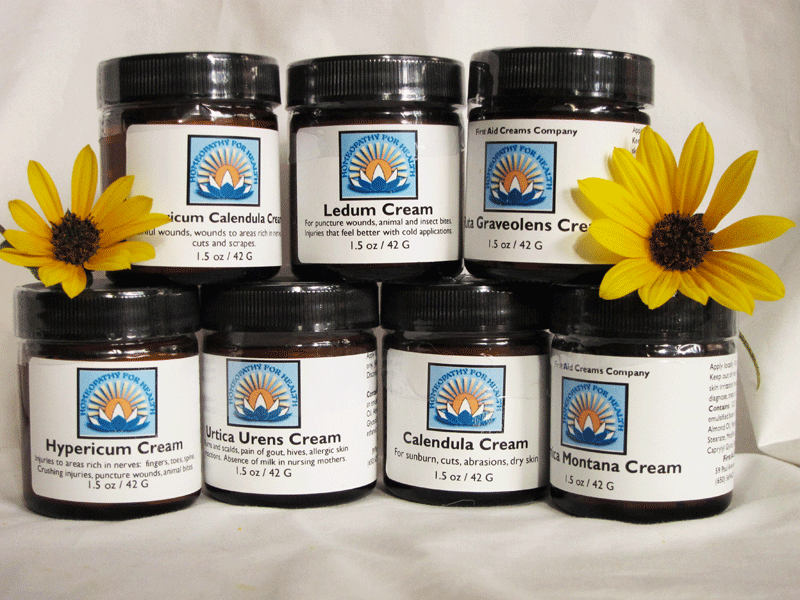We sell homeopathic creams for bone injuries on our site. Each of the creams we sell can assist in bone healing. The remedy best known for stimulating “normal granulation of bones and tissues,” is Symphytum, which I do not sell on my site, but the creams I do sell are also valuable healing agents for bone injuries. Here is a brief description of the action of each cream in the field of bone healing:
Arnica montana: Choudhuri says of Arnica, “Arnica is the king of our traumatic remedies. We use it in injuries of the muscles, fractures of the bones, contusion of the periosteum and in subctaneous and external hemorrhage due to mechanical injuries.” Arnica helps with cranial fractures and splintered bones in the skull. Farrington says, “Fractures of the bones may call for the use of Arnica, both externally and internally, to relieve the swelling and tumefaction of the limb, and also to relieve the twitching of muscles, a reflex symptom of the fracture.” Bruises to the bones from blows and falls can be helped with Arnica. Arnica can also help with injuries to the orbits of the eyes. Dr. Waffensmith says, “Arnica is indicated in the primary stage of injury, especially of the soft parts, in concussions, loos of consciousness, and general shock state.” In bone injuries it is followed well by Ruta and Symphytum.
Calendula: Calendula is another cream that can help with fractures and wounds to the bone. I read a wonderful account by Dr. Petrie Hoyle in a book called, “Heal Thyself,” written in 1933 about the wonders of Calendula in treating wounds, including injured bones. He recounts his wonderful experiences treating wounded French soldiers during WWI. Calendula is listed under compound fractures and to help with slow union of the bones.
Hypericum: Hypericum is our great remedy for injuries to the nervous system, and should be thought of for injuries to the head. It is an important remedy for skull fractures and bone splinters, with heaviness and formication in the brain. It can also be used for fractures and bone injuries where the Hypericum guiding symptoms are present.
Ledum and Rhus toxicodendron are only mentioned slightly for bone injuries.
Ruta graveolens: Ruta graveolens is an important remedy for bruises and mechanical injuries of the bones and the periosteum (the lining of the bones). Here it should be compared to Symphytum. It is useful in fractures, compound fractures and dislocations of the bones. It is useful after a fall when there is a bruised, lame sensation, especially of the wrists and ankles. Ruta helps with bone lesions, such as ganglion cysts. Ruta should be thought of for overuse injuries, such as tendonitis, and carpal tunnel. Think of Ruta for injuries such as a kick in the shins or a punch in the nose. Other uses are for: injuries after carrying heavy weights; injuries to the orbits of the eyes; and deep bone pain after injury.
Symphytum: I do not carry Symphytum cream on my site, but it is such an important remedy for bone injuries that I have to mention it here. Common names for Symphytum are boneset and knitbone, clearly indicating its affinity for bones. Symphytum facilitates the union of fractured bones. It helps with irritable stump after amputation, and for irritable bone at the point of fracture, and with excessive pain after a bone injury (also think of Ruta for this). Other uses are: psoas abscess; pain and soreness of periosteum, black eye, sprains, bone cancer, gingivitis, injuries to the eyeball, tailbone injuries (like Hypericum), pain in old long-healed injuries of the bones, fractures of the skull and splintered bones, osteoporosis.
Learn more about Arnica, Calendula, Hypericum, Ledum and Ruta cream.
Buy Arnica, Calendula, Hypericum, Ledum, and Ruta cream.
***note*** This information is incomplete and not intended to diagnose or treat any medical condition. Please refer to a homeopathic materia medica or homeopathic repertory for a more complete list of remedies for any given symptom. Please see your homeopath or doctor for assistance if your symptoms persist.
